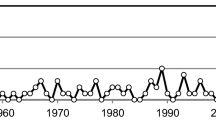Abstract
When inspecting the health of a civil structure, it is important to have efficient techniques to detect the possible presence of structural damage. This work deals with the detection of damage in prestressed concrete structures, which are widely used in road bridges and long span slabs, among others. Concrete structures can be affected by different pathologies, with the transverse cracks beingone of the most dangerous damages, since they involve a localized reduction of the flexural rigidity of the structure. Such cracks change both the static and dynamic behavior of the structure. In this paper, an inverse method of damage detection is applied on two experimental beams built in the laboratory, from the measurement of the first three natural frequencies of vibration. An algorithm for solving the system of equations has been developed by the authors. Explicit equations were obtained to calculate both the crack position and its depth. The predicted damages by the algorithm have been in good agreement with the real damages of the experimental models. An important aspect of this methodology for crack detection is the simplicity of its experimental implementation.
























Similar content being viewed by others
References
Karayannis CG, Chalioris CE (2013) Design of partially prestressed concrete beams based on the cracking control provisions. Eng Struct 48:402–416. https://doi.org/10.1016/j.engstruct.2012.09.020
Yao Y, Tung S-TE, Glisic B (2014) Crack detection and characterization techniques—an overview. Struct Control Health Monit 21:1387–1413. https://doi.org/10.1002/stc.1655
Dai L, Wang L, Zhang J, Zhang X (2016) A global model for corrosion-induced cracking in prestressed concrete structures. Eng Fail Anal 62:263–275. https://doi.org/10.1016/j.engfailanal.2016.01.013
Darmawan SM, Stewart MG (2007) Spatial time-dependent reliability analysis of corroding pretensioned prestressed concrete bridge girders. Struct Saf 29:16–31. https://doi.org/10.1016/j.strusafe.2005.11.002
Lee BY, Koh KT, Ismail MA, Ryu HS, Kwon SJ (2017) Corrosion and strength behaviors in prestressed tendon under various tensile stress and impressed current conditions. Adv Mater Sci Eng. https://doi.org/10.1155/2017/8575816
Calavera J (2005) Patología de Estructuras de Hormigón Armado y Pretensado, 2nd edn. Intemac Ediciones, Madrid
CEB-FIP (1993) Model code 1990: Design code. T. Telford, London
Comisión Permanente del Hormigón (2011) EHE-08 Instrucción de Hormigón Estructural (5th ed.) Ministerio de Fomento, Madrid
Centro de Investigación de los Reglamentos Nacionales de Seguridad para las Obras Civiles (2005) CIRSOC 201 Reglamento Argentino de Estructuras de Hormigón. INTI, Buenos Aires
American Concrete Institute (2014) ACI 318-14: building code requirements for structural concrete and commentary. American Concrete Institute, Farmington Hills
Unger JF, Teughels A, De Roeck G (2006) System identification and damage detection of a prestressed concrete beam. J Struct Eng 132(11):1691–1698. https://doi.org/10.1061/(ASCE)0733-9445(2006)132:11(1691)
Anifantis N, Dimarogonas A (1983) Stability of columns with a single crack subjected to follower and vertical loads. J Solids Struct 19(4):281–291. https://doi.org/10.1016/0020-7683(83)90027-6
Ostachowicz WM, Krawczuk M (1991) Analysis of the effect of cracks on the natural frequencies of a cantilever beam. J Sound Vib 150:191–201. https://doi.org/10.1016/0022-460X(91)90615-Q
Rizos PF, Aspragathos N, Dimarogonas AD (1990) Identification of crack location and magnitude in a cantilever beam from the vibration modes. J. Sound Vibration 138(3):381–388. https://doi.org/10.1016/0022-460X(90)90593-O
Liang RY, Choy FK, Hu J (1991) Detection of cracks in beam structures using measurements of natural frequencies. J Franklin Inst 328:505–518. https://doi.org/10.1016/0016-0032(91)90023-V
Nandwana BP, Maiti SK (1997) Modelling of vibration of beam in presence of inclined edge or internal crack for its possible detection based on frequency measurements. Eng Fract Mech 58:193–205. https://doi.org/10.1016/S0013-7944(97)00078-7
Rosales MB, Filipich CP, Buezas FS (2009) Crack detection in beam-like structures. Eng Struct 31:2257–2264. https://doi.org/10.1016/j.engstruct.2009.04.007
Orbanich CJ, Rosales MB, Ortega NF, Filipich CP (2009) Detección de fallas en vigas de fundación elástica mediante el método inverso. Mecánica Computacional XXVIII:613–631
Mazanoglu K, Sabuncu M (2012) A frequency based algorithm for identification of single and double cracked beams via a statistical approach used in experiment. Mech Syst Signal Process 30:168–185. https://doi.org/10.1016/j.ymssp.2012.02.004
Barad KH, Sharma DS, Vyas V (2013) Crack detection in cantilever beam by frequency based method. Procedia Eng 51:770–775. https://doi.org/10.1016/j.proeng.2013.01.110
Rao SS (2007) Vibration of continuous systems. Wiley, Hoboken
Blevins RD (2001) Formulas for natural frequency and mode shape. Krieger Publishing Company, UK
Wolfram S (2015) An elementary introduction to the wolfram language. Wolfram Media, Inc
Vernier (2008) Labquest interfase. Software and Technology, Beaverton, OR, USA
Vernier (2008) Logger pro 3.6.1. Software and Technology, Beaverton, OR, USA
Nyquist H (1928) Certain topics in telegraph transmission theory. Trans AIEE 47:617–644. https://doi.org/10.1109/T-AIEE.1928.5055024
Shannon E (1949) Communication in the presence of noise. Proc Inst Radio Eng 37:10–21. https://doi.org/10.1109/JRPROC.1949.232969
Clough RW, Penzien J (1995) Dynamics of structures, 2nd edn. McGrawHill, New York
COMSOL (2013) COMSOL Multiphysics User’s Guide, Version 4.4
Jason L, Ghavamianc S, Courtois A (2010) Truss vs solid modeling of tendons in prestressed concrete structures: consequences on mechanical capacity of a representative structural volume. Eng Struct 32:1779–1790. https://doi.org/10.1016/j.engstruct.2010.02.029
Yapar O, Basu PK, Nordendale N (2015) Accurate finite element modeling of pretensioned prestressed concrete beams. Eng Struct 101:163–178. https://doi.org/10.1016/j.engstruct.2015.07.018
Acknowledgements
The authors thank the Department of Engineering and the General Secretariat of Science and Technology of the Universidad Nacional del Sur (UNS), as well as the Consejo Nacional de Investigaciones Científicas y Técnicas (CONICET) and the Comisión de Investigaciones Científicas de la Prov. de Buenos Aires (CIC), for their support to the development of these investigations.
Author information
Authors and Affiliations
Corresponding author
Additional information
Publisher's Note
Springer Nature remains neutral with regard to jurisdictional claims in published maps and institutional affiliations.
Rights and permissions
About this article
Cite this article
Ercolani, G.D., Felix, D.H. & Ortega, N.F. Crack detection in prestressed concrete structures by measuring their natural frequencies. J Civil Struct Health Monit 8, 661–671 (2018). https://doi.org/10.1007/s13349-018-0295-2
Received:
Accepted:
Published:
Issue Date:
DOI: https://doi.org/10.1007/s13349-018-0295-2



